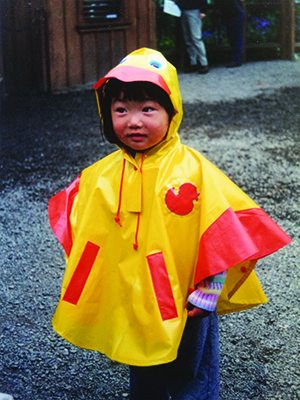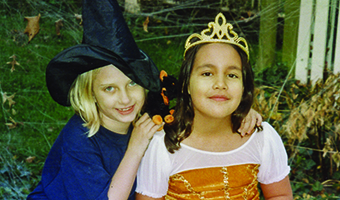When the toddler daughter of a friend was just learning to talk, she spent Halloween shouting, “Trick treat! Trick treat!” She was way ahead of her time, that youngster, for it’s not easy to take the “or” out of this phrase and out of Halloween itself.
Halloween seems to offer yet another opportunity for our polarized culture to show that it’s stuck in an “or” mentality. We seem quite fond of pigeonholing people into “or” positions. Are you politically right or politically left? Saved or not saved? My way or the highway! So, too, with Halloween: Is it a playful day for kids or devil worship?

COURTESY OF MARY LINDBERG
Years ago Halloween seemed much simpler to celebrate. We just watched for Oct. 31 on the calendar and looked for kids in costumes. We’d pull out the two costumes stored in a drawer in the attic and beeline down to the second house from the corner, where the neighbors passed out sticky-sweet homemade popcorn balls every year.
Observing Halloween today can be complicated. Certainly we can find the holiday in some of the same old places (with well-wrapped, store-bought candy, of course). But we also discover Halloween in stores that tout costume and candy sales across several months and in culture war arguments on the Internet about whether it’s sacrilegious or not to observe the holiday.
As Halloween alternately excites or incites those around us, how shall we think of it — as a hollow trick or a traditional treat?
Maybe we could start, like our friend’s daughter, by leaving the “or” out of Halloween. After all, since ancient times Halloween has been about death and life.
Traditionally, All Hallows’ Eve was celebrated the night before All Saints Day, with bonfires, feasting on apples and nuts, and mocking evil with costumes and masks. All Saints Day was celebrated with worship services that used hymns and liturgy to remember the saints and proclaim God’s promises of eternal life.

KATHRYN BREWER
Together these two events formed an eve and a holiday, like so many of our special celebrations. Their hybrid blend of an ancient fire festival and a religious feast personified humanity’s many images and feelings about death and a world beyond their own. Not merely evil or good, but mysterious and redeemed.
Perhaps we can draw inspiration from the ways our predecessors observed All Hallows’ Eve and All Saints Day together. “At Halloween, everything spooky, unseen, mysterious, or otherworldly connects to the souls of the dead which the church celebrates in its feast at this time of the year. Perhaps it is a time to channel some very basic human fears and fascinations,” wrote Gertrud Mueller Nelson in To Dance with God: Family Ritual and Community Celebration (Paulist Press, 1968).
Other cultures seem much more comfortable than ours with seamlessly blending caricatures of death and lives of the saints. For example, Día de los Muertos (Day of the Dead) is celebrated on All Saints Day (Nov. 1) in Mexico. To understand death as a natural part of the circle of life, the dead are roused from sleep on Día de los Muertos to commune with their loved ones. Family members adorn the graves of their departed with the things they loved — special foods and pictures of friends and family.
To add to the celebration, mischievous skeletons and skull candies, called calacas and calaveras, are displayed in bakery windows and cemeteries.
Amid a culture of “or” thinking, during the month in which we observe a trick-or-treat holiday, I think God is inviting us to be “and” Lutherans. What if your family celebrated Halloween and All Saints Day this year?
We could take a page from the playbook of Katie and Joey Coleman of Seattle, parents of Henry and Jack, who said, “We have fun on Halloween by gathering with old friends, meeting new neighbors and sharing generously with people who come to our door. That spirit of community — among the living and the dead — is extended in All Saints Day when we bring pictures of grandparents and friends who have passed away to church.
“We love celebrating both holidays together and letting our kids know they are part of a big community of neighbors known and unknown, saints alive and dead.”
Ideas for observing Halloween and All Saints Day
During their participation in a community Halloween celebration, members of Church of the Beloved in Edmonds, Wash., offered trick-or-treaters both candy and a chance to light a candle in honor of a departed loved one (www.elca.org/en/Living-Lutheran/Stories/2011/10/111019).
“On All Saints Day, take a walk with your children in a nearby cemetery. Wonder about the people buried there and stories the headstones might suggest. Share stories of members of your family and congregation who have died, especially stories about how they lived their lives of faith. Affirm the lives and service of those who now rest in God and the love they received from God throughout their lives” (excerpt from Living the Promises of Baptism: 101 Ideas for Parents; Augsburg Fortress, 2010).
Many sites in the U.S. now host Día de los Muertos (Day of the Dead) festivities that are open to the public. Research what’s available in your area and introduce your children or grandchildren to a rich celebration of life and death.





